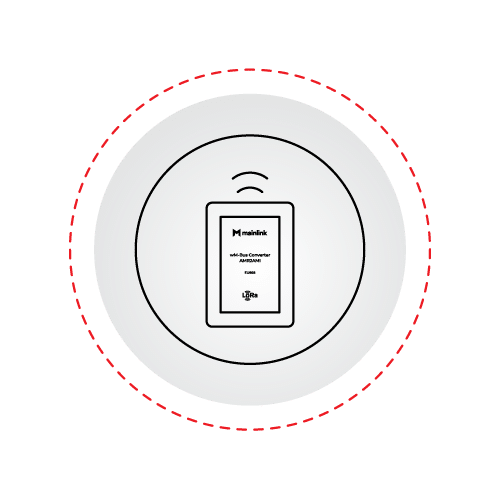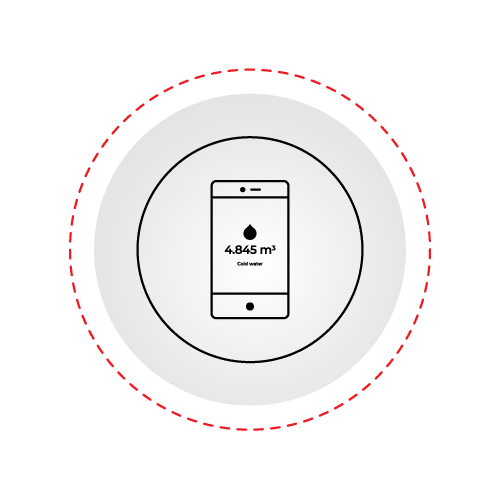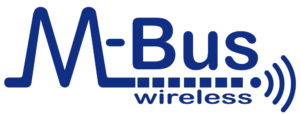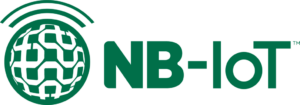Smart Metering for Utilities
Connect all your smart water meters or heat meters with our end-to-end smart metering solution for water, heating, cooling and electricity utilities. Enjoy cost efficiency, simplified billing and streamlined operations. Our solution supports existing infrastructure, it is both hardware-and-network agnostic and can be integrated with 3rd party systems.
Key Components of Smart Metering

Choose any smart meters or utilize your existing meters with our gateways and converters.

Gateway
The converter collects data remotely from various types of meters and transmits it through the LoRaWAN network.

Mainnet
Complete carrier-grade LoRaWAN network used for smart meter communication, that requires no additional resources to manage.

Mainhive
Cloud platform utilizing advanced technology to securely process and analyze data, automate processes and easily integrate with existing systems.

App
Empower end-users to monitor their utilities usage with our user-friendly app.
Benefits

- Single point of contact
- Automated data for invoicing
- Easy-to-use platform
- No need for drive-by systems to collect data

- No large initial investments
- Wide connectivity options
- Hardware agnostic
- Free and continuous platform support and updates
- Professional consultation for network planning
- Efficient handling of non-revenue usage

- Flexibility to choose from multiple hardware or use existing one
- Choose network type for a future-proof solution without being locked to a provider

- Comply with the latest regulations and laws
- Ensure sustainable operations
Smart Metering Applications
Effortlessly integrate legacy metering infrastructure into the smart metering solution by upgrading or connecting pulse, Mbus, wM-Bus and other meters. Our solution supports the legacy infrastructure without the need for a complete replacement of all meters.
Without a doubt, smart ultrasonic meters are the future for water and heating metering. They excel in accuracy and offer long-term measurement stability and reliability. By partnering with leading ultrasonic meter manufacturers, we can assist in deploying new smart metering systems.
Simplify your billing process with our smart metering solution. The data for billing can be easily exported to your invoicing platform via API integration, or it can be provided as a standalone file.
Take control of non-revenue water with our solution. Receive instant alerts about leakages and water thefts. Compare the group of meters assigned to the main meter to spot any discrepancies. Monitor water consumption patterns and leverage machine learning to detect potential NRW.
Easily combine individual meters into groups and monitor them, as well as compare your district metered zones.
Communication protocols and technologies
The quick rise of the Internet of Things (IoT) led to various communication protocols and technologies being used in smart metering. With new connectivity providers entering the market, customers have a growing number of options to choose from.
Our solution supports all widely-used technologies including LoRaWAN, NB-IoT, Sigfox, WM-Bus, and others. Our experts will assist you in selecting the best option based on your specific needs and advantages of each technology.
The LoRaWAN® specification is a Low Power, Wide Area (LPWA) networking protocol designed to wirelessly connect battery operated ‘things’ to the internet in regional, national or global networks, and targets key IoT requirements such as bi-directional communication, end-to-end security, mobility and localization services.
LoRaWAN® network architecture is deployed in a star-of-stars topology in which gateways relay messages between end-devices and a central network server. The gateways are connected to the network server via standard IP connections and act as a transparent bridge, simply converting RF packets to IP packets and vice versa. The wireless communication takes advantage of the Long Range characteristics of the LoRaÒ physical layer, allowing a single-hop link between the end-device and one or many gateways. LoRa offers great coverage from a single gateway (<20km) which supports thousands of end devices, low costs for network deployment and long end device battery life.
Wireless M-Bus or Wireless Meter-Bus is the European standard (EN 13757-4) that specifies the communication between utility meters and data loggers, concentrators or gateways, allowing to get remote and wireless data readings on a regular basis. Until more advanced and effective ways were created this method became quite popular in Advanced Metering Infrastructure (AMI) and is widely used for electricity, gas, water, and heat meters.
We offer solutions, allowing to gather data from multiple Wireless M-Bus devices directly or integrating them into the growing LoRaWAN® network, saving on deployment costs and avoiding tiresome drive-by, walk-by scenarios. That allows utilities to have newest LoRa devices implemented where the replacement is already planned and have data from legacy ones in one system till their service time ends.
NB-IoT is a Narrow Band IoT technology specified in Release 13 of the 3GPP in June 2016. NB-IoT can coexist with GSM (global system for mobile communications) and LTE (long-term evolution) under licensed frequency bands (e.g., 700 MHz, 800 MHz, and 900 MHz). NB-IoT occupies a frequency band width of 200 KHz, which corresponds to one resource block in GSM and LTE transmission.
NB-IoT has the lowest range and coverage capabilities (i.e., range <10 km). It focuses primarily on the class of devices that are installed at places far from the typical reach of cellular networks (e.g., indoors, deep indoors). In addition, the deployment of NB-IoT is limited to LTE base stations. Thus, it is not suitable for rural or suburban regions that do not benefit from LTE coverage.
NB-IoT also offers the advantage of maximum payload length. It allows the transmission of data of up to 1600 bytes. NB-IoT is preferred for applications that require guaranteed quality of service, but this comes at the energy cost – the end-devices have lower lifetime as compared to Sigfox and LoRa.
Sigfox is an LPWAN network operator that offers an end-to-end IoT connectivity solution based on its patented technologies. Sigfox deploys its proprietary base stations equipped with cognitive software-defined radios and connect them to the back end servers using an IP-based network. The end devices connected to these base stations using binary phase-shift keying (BPSK) modulation in an ultra-narrow band (100 Hz) sub-GHZ ISM band carrier.
Sigfox uses unlicensed ISM bands. By employing the ultra-narrow band, Sigfox uses the frequency bandwidth efficiently and experiences very low noise levels, leading to very low power consumption, high receiver sensitivity, and low-cost antenna design at the expense of maximum throughput. Sigfox proposes the lowest payload length of 12 bytes, which limits its utilization on various IoT applications that need to send large data sizes.
Mainhive supports the devices and the data gathered through Sigfox network allowing to see them on the pair to the devices working on other networks.
Don’t know which option would be suitable for your business? We will provide you professional consultation.
Use cases

Billing

Non-revenue water detection
Our solution offers three effective ways to detect water leaks and thefts, helping you to minimize non-revenue water and increase your revenue streams.

Operational efficiency
Remote consumption monitoring, automatic alerts, machine learning and other features will streamline your operations.
Contact form
Discover how simple it can be to get more value from new and existing metering infrastructure




